
by Meg Marquardt Monday, June 20, 2016
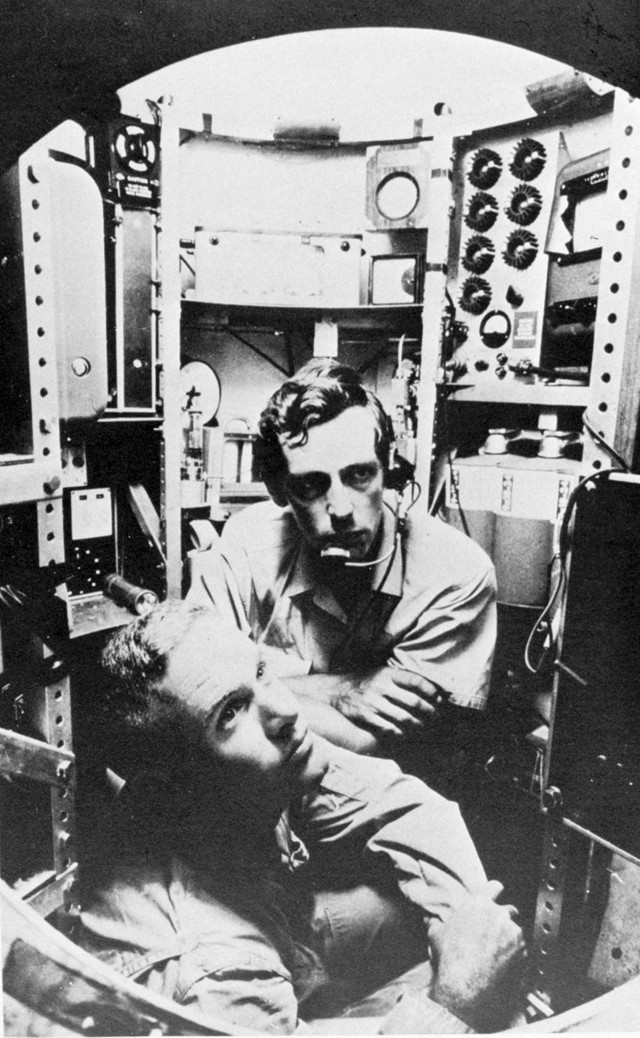
Jacques Piccard and Don Walsh in the crew cabin as the Trieste descends to Challenger Deep. Credit: NOAA.
More than 9,000 meters underwater, a window buckles, sending a spider web of cracks across the glass. The entire submersible shakes, but no water rushes into the Trieste. Out of vocal contact with the main ship on the surface above them, Swiss oceanographer and engineer Jacques Piccard and U.S. Navy Lt. Don Walsh decide to continue their descent despite the new danger. After all, at more than nine kilometers below the sea surface, the explorers were too close to their goal to turn around. They were only 2,000 meters away from the deepest spot on Earth: Challenger Deep. On Jan. 23, 1960, they reached that fabled point 10,916 meters below the surface of the Pacific Ocean.
Challenger Deep is a valley at the southern tip of the Mariana Trench, a 2,550-kilometer-long trough southeast of Japan. It is part of the Izu-Bonin-Mariana arc system, a tectonic convergent plate boundary where the western Pacific Plate is pulled into the mantle beneath the eastern Philippine Plate, creating the long trench. This subduction also created Challenger Deep, now officially measured at 10,971 meters below the surface. The depth is mind-boggling: If Mount Everest, the tallest mountain on Earth at 8,848 meters, were dropped into Challenger Deep, 2,000 meters of water would cover the mountain’s peak.
Challenger Deep was conquered seven years after Sir Edmund Hillary and Tenzing Norgay ascended Everest. And just like climbing to the top of the world, sinking to its bottom posed a unique set of challenges. At 11,000 meters deep, water pressure is more than 1,000 times what it is at the surface. In 1960, the deepest dive ever recorded was 5,532 meters by the Trieste itself, still almost 5,500 meters shallower than the Challenger Deep.
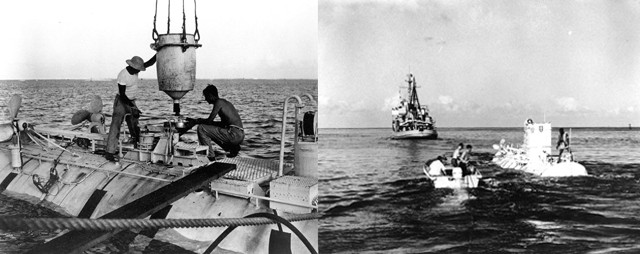
Jacques Piccard helps load the ballast before a test dive in the Mariana Trench. The ballast would be dropped once the submersible was ready to ascend back to the surface after its record dive. Far right: The Trieste leaves Guam for a test dive in November 1959. Credit: U.S. Naval Historical Center.
Trieste was designed by Swiss physicist Auguste Piccard, father of Jacques and holder of the aviation altitude record at 23,000 meters in a balloon. The Trieste submersible, named for the Italian city-state in which it was built, was a bathyscaphe, a class of deep-sea submersibles that consisted of a cylindrical body full of float tanks that hold lighter-than-water gasoline. This part of the design was key to the Trieste’s success. Gasoline is practically incompressible, meaning the buoyant liquid can be housed in relatively lightweight tanks, because the exterior and interior pressure easily equalizes as the bathyscaphe descends. The light material of the tanks is countered by the heavier material of the crew cabin, a sturdy Plexiglas and metal bubble attached below the float tanks.
The Trieste first launched in 1953 as a deep-diving vessel for the French Navy. Once the U.S. Navy saw the Trieste in action as it completed dives in the Mediterranean, the Navy wanted it. The Navy had been on the hunt for a vessel that could be used in Project Nekton, which was, according to a Navy announcement at the time, created to investigate “scientific knowledge of sunlight penetration, underwater visibility, transmission of man-made sounds, and marine geological studies.” The Navy wanted to push the boundaries of deep-sea diving, to investigate the site where two British Royal Navy vessels (both named the HMS Challenger) had pinpointed the deepest spot in the ocean. At the time of the dive, echo sounding showed the valley of Challenger Deep at 10,900 meters.
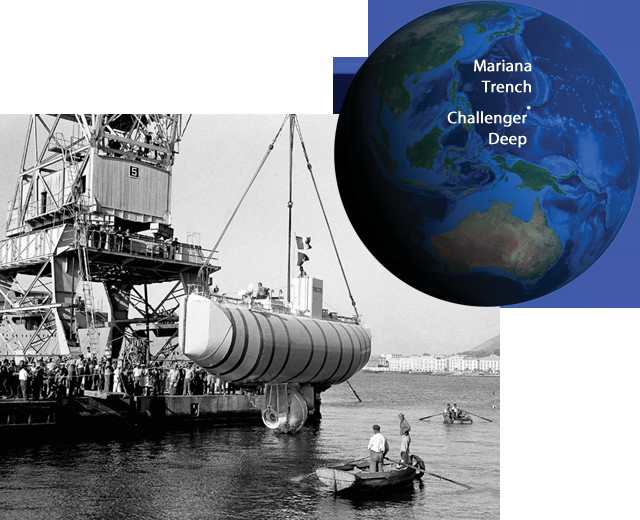
A crane lowers the Trieste into the water at the Castellammare shipyards in Italy where the diving craft was constructed. On Sept. 30, 1953, the Trieste beat all previous records, diving to a depth of 3,150 meters. Credit: globe: AGI/NASA; image: AP Photo/Ugo Sarto.
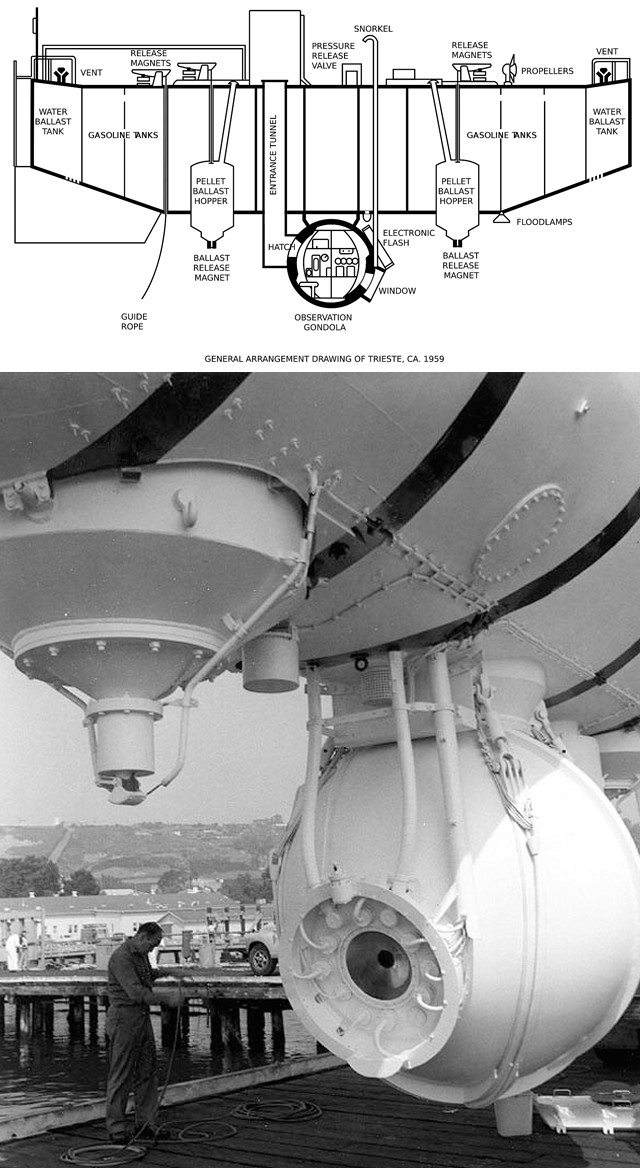
Right: A schematic of the Trieste shows the small size of the crew cabin, the bubble under the main structure of the vessel (as seen below). Only two people could fit in the cabin at a time. Credit: bottom: U.S. Naval Historical Center; top: Ralph Sutherland.
To reach the bottom of the ocean, the Navy hired Jacques Piccard, an experienced deepsubmersible pilot who had previously worked on the Trieste. The crew cabin of the submersible could only hold one other person, so Lt. Don Walsh, a member of Project Nekton, became the co-pilot. The Trieste left San Diego, Calif., on Oct. 5, 1959, making the more than 10,000-kilometer trip to the Mariana Trench. When Piccard, Walsh and the rest of the Project Nekton team reached the trench, they conducted further experiments before the full dive occurred. They performed new echo sounding tests — dropping sticks of TNT and waiting for the returning echo, the longest of which took 14 seconds — to locate the precise location of Challenger Deep; meanwhile, the Trieste conducted some tests dives. On Jan. 7, 1960, it set a record dive depth at 7,000 meters, 1,500 meters deeper than any submersible had ever gone before.
On Jan. 23, Piccard and Walsh began their final dive. According to Walsh’s report, sunlight penetrated for 240 meters before the sea fell to darkness. Over the course of four hours and 48 minutes, the Trieste descended as water slowly filled the open ballast tanks and gasoline was released from the float tanks. At the halfway mark, their communication system — a sort of telephone that transmitted their voices as sonar waves — failed. The only way to communicate was by sending tone pulses: an odd number of pulses to indicate a problem had occurred and an even number of pulses to signal normal operations. At 9,000 meters, that fabled crack in the window to the entrance tunnel occurred. And at 10,916 meters, they reached the bottom of the world.
Upon reaching their destination, Piccard and Walsh started to explore. They flipped on the light attached to the Trieste and were shocked to see, in the flood of artificial light, sea creatures — a white, flat fish and small red shrimp — swimming around the craft. The report was surprising to say the least; at the time, scientists had been relatively certain that nothing could live at such a depth due to pressure, complete lack of light and little oxygen. The appearance of living creatures was proof that there was a supply of oxygen to the deepwater. After less than 30 minutes — with temperatures close to 7 degrees Celsius, they could only spend 20 minutes on the seafloor — Piccard and Walsh dropped the iron shot that was used in bathyscaphes as ballast in the place of compressed air, and began the threehour ascent to the surface, and into the history books as the greatest explorers of the ocean’s depths.
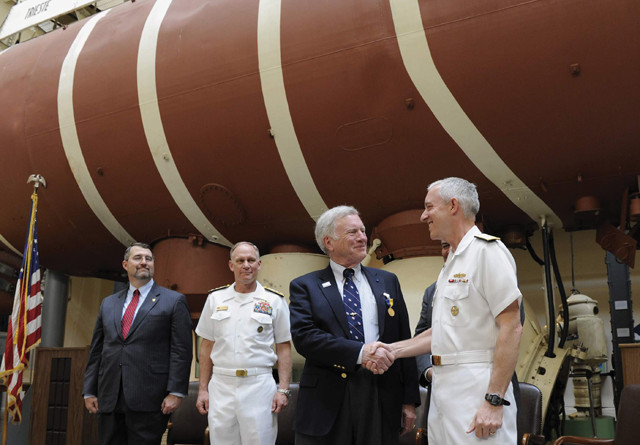
In April 2010, Don Walsh (second from right) received the Navy Distinguished Public Service Award. In the same year, he received the Hubbard Medal from the National Geographic Society, the highest award the society gives for people who exemplify exploration, discovery and research. Credit: U.S. Navy photo by John F. Williams.
Challenger Deep is frequently compared to Mount Everest, but it bests the great mountain in at least one category: number of visitors. Since Hillary and Norgay’s ascent, Everest has been scaled by many intrepid adventurers. In the 50 years since Piccard and Walsh made their dive, no person has returned to the bottom of Challenger Deep. But a gauntlet has been thrown. In early 2011, the X Prize Foundation is expected to set an award of least $10 million to the first privately funded manned submersible to visit Challenger Deep twice. And filmmaker James Cameron is trying as well. If he makes it, watch for footage in an “Avatar” sequel.
© 2008-2021. All rights reserved. Any copying, redistribution or retransmission of any of the contents of this service without the expressed written permission of the American Geosciences Institute is expressly prohibited. Click here for all copyright requests.